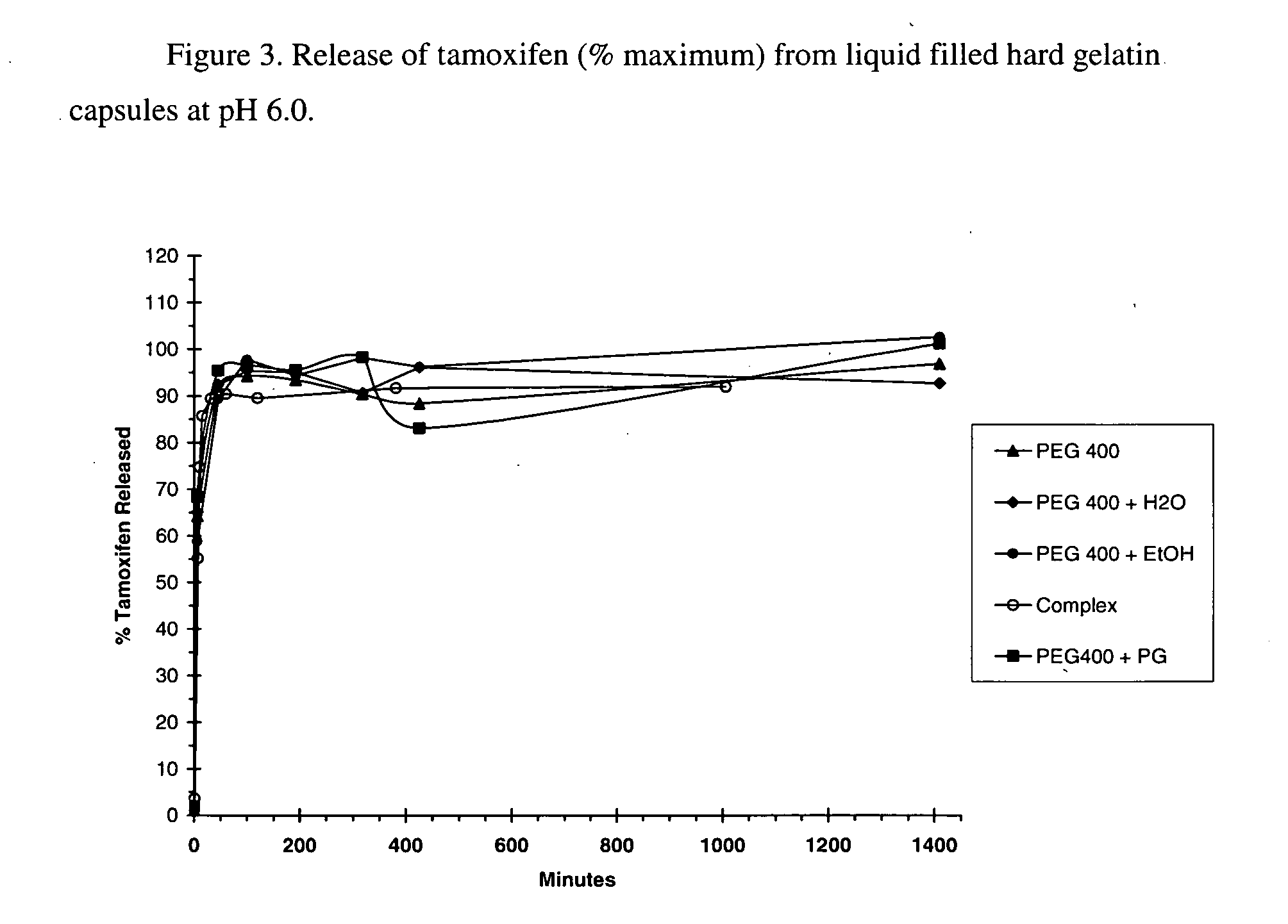Cyclodextrin solubilizers for liquid and semi-solid formulations
a technology of cyclodextrin and solubilizer, which is applied in the direction of capsule delivery, biocide, animal husbandry, etc., can solve the problems of unmodified cyclodextrin, limited ability to solubilize and stabilize guest molecules in aqueous environment, renal and liver damage,
- Summary
- Abstract
- Description
- Claims
- Application Information
AI Technical Summary
Benefits of technology
Problems solved by technology
Method used
Image
Examples
example 1
Solubility of Hydroxybutenyl Cyclodextrins in Selected Water-Miscible Organic Solvents
[0068] In the following experiments, PEG 400 and propylene glycol were dried over molecular sieves prior to use and the H2O content was determined by Karl Fisher titration (PEG 400=0.238 wt % H2O; PG=0.179 wt % H2O). The ethanol (EtOH) was absolute EtOH and the water was prefiltered through a Millipore Milli-Q Water System. The hydroxybutenyl-β-cyclodextrin (MS=4.7, HBenβCD4.7) was carefully dried prior to use.
[0069] The appropriate solvent and HBenβCD4.7 were weighed into glass vials with screw caps. The samples were briefly (ca. 2 min) heated to 60° C. and then allowed to mix by gently rolling the vials overnight. The solubility of the HBenβCD4.7 in the selected solvent was determined after the initial heating and after rolling overnight. Table 1 provides the composition of the mixtures evaluated for solubility.
TABLE 1Composition of hydroxybutenyl-β-cyclodextrin and water-miscibleorganic solv...
example 2
Initial Screening for Solubility of Selected Drugs in Hydroxybutenyl Cyclodextrins:Water-Miscible Organic Formulations
[0072] In the following experiments, the water-miscible solvents were dried as described in example 1. The hydroxybutenyl-β-cyclodextrins (HBenβCD6.6 and HBenβCD5.0) and the sulfonated hydroxybutenyl-β-cyclodextrins (MSsulfonate=0.3, MSbutentyl=4.4) were carefully dried prior to use. The following stock solutions were prepared:
[0073] 1. HBenβCD5.0 (30 wt %) and PEG 400 (70 wt %)
[0074] 2. HBenβCD5.0 (30 wt %), PEG 400 (66.2 wt %), and EtOH (3.8 wt %)
[0075] 3. HBenβCD5.0 (30 wt %), PEG 400 (66.2 wt %), and PG (3.8 wt %)
[0076] 4. HBenβCD6.6 (32 wt %) and PEG 400 (68 wt %)
[0077] 5. HBenβCD6.6 (32 wt %), PEG 400 (64.6 wt %), and EtOH (3.4 770629 wt %)
[0078] 6. HBenβCD6.6 (32 wt %), PEG 400 (64.6 wt %), and PG (3.4 wt %)
[0079] 7. SulfoHBenCD (29 wt %), PEG 400 (67.6 wt %), and EtOH (3.4 wt %)
[0080] Various drugs (20-22 mg) were weighed into different glass vials w...
example 3
Solubility of Tamoxifen in Hydroxybutenyl Cyclodextrins:Water-Miscible Organic Solvent Mixtures
[0083] Following the procedures similar to those of example 2, tamoxifen was solubilized in selected HBenβCD4.7:solvent mixtures. For every sample, the amount of material weighed was 29.4:68.6:2.1 HBenβCD4.7:solvent:tamoxifen. In the case of binary solvents (Table 2), the ratio was 96.7:3.3 PEG400:cosolvent. The samples were allowed to mix until a solution with no visible particles was obtained. The samples were then analyzed by 1H NMR. The results are summarized in Table 3.
TABLE 3Tamoxifen (w / w drug / CD) solubilized by HBenβCD4.7 inthe indicated solvent system as determined by1H NMR.Drug:HBenCDSampleSolvent(w / w)1PEG 4006.72PEG 400 + H2O6.63PEG 400 + EtOH6.54PEG 400 + PG5.7
[0084] This example illustrated that hydrophobic drugs such as tamoxifen can be solubilized with hydroxybutenyl-β-cyclodextrins in the nonaqueous solvent systems of the present invention. As controls, the solubility of...
PUM
| Property | Measurement | Unit |
|---|---|---|
| wt % | aaaaa | aaaaa |
| temperature | aaaaa | aaaaa |
| wt % | aaaaa | aaaaa |
Abstract
Description
Claims
Application Information
 Login to View More
Login to View More - R&D
- Intellectual Property
- Life Sciences
- Materials
- Tech Scout
- Unparalleled Data Quality
- Higher Quality Content
- 60% Fewer Hallucinations
Browse by: Latest US Patents, China's latest patents, Technical Efficacy Thesaurus, Application Domain, Technology Topic, Popular Technical Reports.
© 2025 PatSnap. All rights reserved.Legal|Privacy policy|Modern Slavery Act Transparency Statement|Sitemap|About US| Contact US: help@patsnap.com



